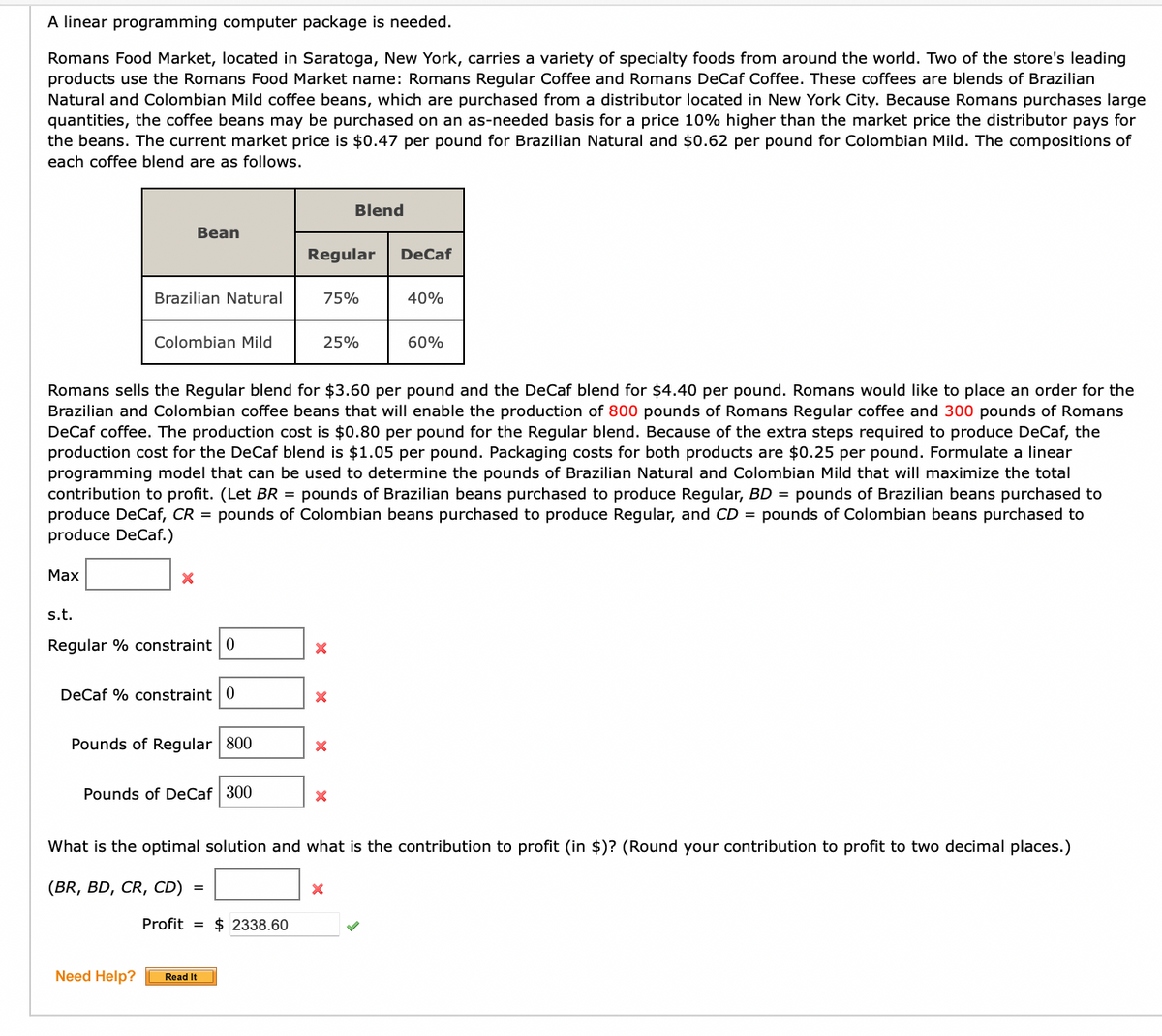Max X s.t. Regular % constraint 0 X DeCaf % constraint 0 X Pounds of Regular 800 X Pounds of DeCaf 300 X What is the optimal solution and what is the contribution to profit (in $)? (Round your contribution to profit to two decimal places.) (BR, BD, CR, CD) = X Profit $2338.60
Max X s.t. Regular % constraint 0 X DeCaf % constraint 0 X Pounds of Regular 800 X Pounds of DeCaf 300 X What is the optimal solution and what is the contribution to profit (in $)? (Round your contribution to profit to two decimal places.) (BR, BD, CR, CD) = X Profit $2338.60
Practical Management Science
6th Edition
ISBN:9781337406659
Author:WINSTON, Wayne L.
Publisher:WINSTON, Wayne L.
Chapter8: Evolutionary Solver: An Alternative Optimization Procedure
Section: Chapter Questions
Problem 22P
Related questions
Question
help please

Transcribed Image Text:A linear programming computer package is needed.
Romans Food Market, located in Saratoga, New York, carries a variety of specialty foods from around the world. Two of the store's leading
products use the Romans Food Market name: Romans Regular Coffee and Romans DeCaf Coffee. These coffees are blends of Brazilian
Natural and Colombian Mild coffee beans, which are purchased from a distributor located in New York City. Because Romans purchases large
quantities, the coffee beans may be purchased on an as-needed basis for a price 10% higher than the market price the distributor pays for
the beans. The current market price is $0.47 per pound for Brazilian Natural and $0.62 per pound for Colombian Mild. The compositions of
each coffee blend are as follows.
Blend
Bean
Regular
DeCaf
Brazilian Natural
75%
40%
Colombian Mild
25%
60%
Romans sells the Regular blend for $3.60 per pound and the DeCaf blend for $4.40 per pound. Romans would like to place an order for the
Brazilian and Colombian coffee beans that will enable the production of 800 pounds of Romans Regular coffee and 300 pounds of Romans
DeCaf coffee. The production cost is $0.80 per pound for the Regular blend. Because of the extra steps required to produce DeCaf, the
production cost for the DeCaf blend is $1.05 per pound. Packaging costs for both products are $0.25 per pound. Formulate a linear
programming model that can be used to determine the pounds of Brazilian Natural and Colombian Mild that will maximize the total
contribution to profit. (Let BR = pounds of Brazilian beans purchased to produce Regular, BD = pounds of Brazilian beans purchased to
produce DeCaf, CR= pounds of Colombian beans purchased to produce Regular, and CD = pounds of Colombian beans purchased to
produce DeCaf.)
Max
X
s.t.
Regular % constraint 0
X
DeCaf % constraint 0
X
Pounds of Regular 800
X
Pounds of DeCaf 300
X
What is the optimal solution and what is the contribution to profit (in $)? (Round your contribution to profit to two decimal places.)
(BR, BD, CR, CD) =
X
Profit $2338.60
Need Help?
Read It
Expert Solution
This question has been solved!
Explore an expertly crafted, step-by-step solution for a thorough understanding of key concepts.
This is a popular solution!
Trending now
This is a popular solution!
Step by step
Solved in 2 steps with 6 images

Recommended textbooks for you

Practical Management Science
Operations Management
ISBN:
9781337406659
Author:
WINSTON, Wayne L.
Publisher:
Cengage,

Practical Management Science
Operations Management
ISBN:
9781337406659
Author:
WINSTON, Wayne L.
Publisher:
Cengage,